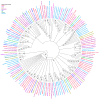Diversity, Lifestyle, Genomics, and Their Functional Role of Cochliobolus, Bipolaris, and Curvularia Species in Environmental Remediation and Plant Growth Promotion under Biotic and Abiotic Stressors
- PMID: 36836368
- PMCID: PMC9962790
- DOI: 10.3390/jof9020254
Diversity, Lifestyle, Genomics, and Their Functional Role of Cochliobolus, Bipolaris, and Curvularia Species in Environmental Remediation and Plant Growth Promotion under Biotic and Abiotic Stressors
Abstract
Cochliobolus, Bipolaris, and Curvularia genera contain various devastating plant pathogens that cause severe crop losses worldwide. The species belonging to these genera also perform a variety of diverse functions, including the remediation of environmental contaminations, beneficial phytohormone production, and maintaining their lifestyle as epiphytes, endophytes, and saprophytes. Recent research has revealed that despite their pathogenic nature, these fungi also play an intriguing role in agriculture. They act as phosphate solubilizers and produce phytohormones, such as indole acetic acid (IAA) and gibberellic acid (GAs), to accelerate the growth of various plants. Some species have also been reported to play a significant role in plant growth promotion during abiotic stresses, such as salinity stress, drought stress, heat stress, and heavy metal stress, as well as act as a biocontrol agent and a potential mycoherbicide. Similarly, these species have been reported in numerous industrial applications to produce different types of secondary metabolites and biotechnological products and possess a variety of biological properties, such as antibacterial, antileishmanial, cytotoxic, phytotoxic, and antioxidant activities. Additionally, some of the species have been utilized in the production of numerous valuable industrial enzymes and biotransformation, which has an impact on the growth of crops all over the world. However, the current literature is dispersed, and some of the key areas, such as taxonomy, phylogeny, genome sequencing, phytohormonal analysis, and diversity, are still being neglected in terms of the elucidation of its mechanisms, plant growth promotion, stress tolerance, and bioremediation. In this review, we highlighted the potential role, function, and diversity of Cochliobolus, Curvularia, and Bipolaris for improved utilization during environmental biotechnology.
Keywords: Bipolaris; Curvularia; abiotic stress; biocontrol; bioremediation; diverse role; enzymes; fungi; phytohormones.
Conflict of interest statement
The authors have declared that no competing interest exist.
Figures


References
-
- Yuvaraj M., Ramasamy M. Biostimulants in Plant Science. IntechOpen; London, UK: 2020. Role of Fungi in Agriculture.
-
- Carrol G.C. Microbiology of Phyllosphere. Cambridge University Press; London, UK: 1986. The biology of endophytism in plants with particular reference to woody perennials; pp. 205–222.
-
- Hussain A., Hamayun M., Rahman H., Iqbal A., Shah M., Irshad M., Qasim M., Islam B. Bioremediation of hexavalent chromium by endophytic fungi; safe and improved production of Lactuca sativa L. Chemosphere. 2018;211:653–663. - PubMed
-
- Bilal L., Asaf S., Hamayun M., Gul H., Iqbal A., Ullah I., Lee I.-J., Hussain A. Plant growth promoting endophytic fungi Asprgillus fumigatus TS1 and Fusarium proliferatum BRL1 produce gibberellins and regulates plant endogenous hormones. Symbiosis. 2018;76:117–127. doi: 10.1007/s13199-018-0545-4. - DOI
-
- Ikram M., Ali N., Jan G., Jan F.G., Rahman I.U., Iqbal A., Hamayun M. IAA producing fungal endophyte Penicillium roqueforti Thom., enhances stress tolerance and nutrients uptake in wheat plants grown on heavy metal contaminated soils. PLoS ONE. 2018;13:e0208150. doi: 10.1371/journal.pone.0208150. - DOI - PMC - PubMed
Publication types
LinkOut - more resources
Full Text Sources

